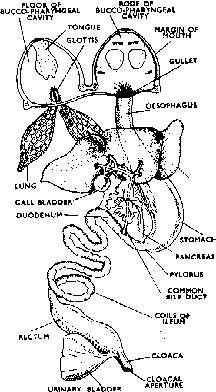
Digestive and Respiratory System of Frog
Anatomy of Earthworm,Cockroach & Frog of Class 11
Digestive System
- The frog feeds up on small insects, worms, slugs, snails etc. It is typically carnivorous. It captures its food alive and then swallows. Swallowing is aided by mucus secreted in the buccal cavity for lubrication. It rejects motionless animals.
- Mouth is wide slit-like ; upper jaw bears maxillary and vomerine (Acrodont) teeth to prevent escape of prey. Lower jaw — without teeth. Salivary glands are absent in frog.
- Forked tongue is attached to the tip of lower jaw. Buccal cavity opens into short pharynx and oesophagus. Anterior end of tongue is attached, posterior end is free.
- Stomach is divisible into cardiac and pyloric parts. Gastric juice has pepsin (activated by HCl) to digest proteins into proteoses and peptones. Mucin prevents the stomach wall from the action of pepsin.
- Partially digested acidic chyme enters duodenum followed by ileum. There is no division of small and large intestine. Intestine opens into rectum which opens into cloaca through anus.
- Liver (Bile juice), pancreas and intestinal glands are associated with the intestine. Liver is the largest gland, compact, brownish and three-lobed. Left lobe is largest and is further divided into secondary lobes. Gall bladder is present between right and left liver lobes and acts as a reservoir for storage of bile.
- Bile juice has bile salts (sodium glycocholate/sodium taurocholate) and bile pigments (bilirubin and biliverdin). Enzymes are absent in bile juice.

Fig. The digestive System of Frog
- Pancreas is flat, lobed, yellowish gland located in the mesentery between stomach and the duodenum. Pancreatic juice contains trypsinogen (for protein digestion), amylopsin (for carbohydrate digestion) and lipase (lipid digestion). Intestinal glands are numerous, single-celled glands in the mucosa of the ileum and secrete intestinal juice or succus entericus.
- Digested food is absorbed through the wall of ileum. Villi increase the surface area of absorption. Amino acids and glucose are directly absorbed into blood while fatty acids and glycerol are absorbed into blood through lacteals present in villi.
Respiratory System
Three types of respiration : cutaneous, buccopharyngeal and pulmonary.
Cutaneous respiration (35% of respiration) is through the body surface. During hibernation and aestivation, frog respires only through this method.
Buccopharyngeal respiration occurs through the lining of buccal cavity. It occurs only when frog is out of water (0.9% of total respiration). The mucus membrane of the buccal cavity is moist which dissolves oxygen and diffuses it into the blood capillaries.
Lungs in frog are not efficient respiratory organs because only mixed blood enters into them and mainly function as hydrostatic organs. Lungs are a pair of thin walled, translucent with inner surface divided into alveoli by septa.
Respiratory movements in pulmonary respiration are because of buccopharyngeal cavity which acts as a force pump. These movements are carried out by set of paired muscles – sternohyal and pterohyal muscles.
Sternohyal muscles are attached with hyoid and coracoid, clavicles of the pectoral girdle and on contraction depresses the buccal floor enlarging the buccopharyngeal cavity.
Pterohyals are attached in between hyoid and pro-optics of the skull and on contraction lifts the floor of buccal cavity. With the depression of buccal floor, air enters buccal cavity through the nares.
External nares are then closed by pushing tuberculum prelinguale and the movable premaxillae. It is followed by raising of the buccal floor by pterohyal muscles which reduces the volume and the air is pushed into the lungs where exchange of gases takes place.
Buccal floor is again lowered enlarging its volume which draws air into the buccal cavity.
External nares are opened followed by raising the buccal floor, pushing the air out through external nares.
Sound producing organ of frog is laryngo-tracheal chamber. It is supported by one cricoid, two arytenoids and two prearytenoids. It has a pair of muscle strands vocal cords which actually produce sound. Male frog has vocal sacs which act as resonating chambers.





